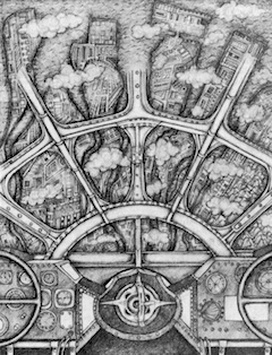|
J. William T. "Bill" Youngs, American Realities, Volume Two:
Historical Episodes from Reconstruction to the Present, Chapter Ten |
"Hiroshima" courtesy of the Wikipedia Commons
|
10. Total War
|
SummaryThe essay describes the most deadly act of violence ever carried out by human beings. The article centers on Hiroshima as event: the Enola Gay’s flight, life in the city before the bombing, the moment of destruction,and the aftermath among the Japanese and the Americans. It suggests that the most remarkable thing about Hiroshima is not that the bombing was an extraordinary act, but that the course of total war to that point had made the use of the atomic bomb seem a logical, even an inevitable, extension of previous policies.
|
Author reads from the Text
When America entered World War II in 1941, President Roosevelt established a scientific advisory committee, including Secretary of War Henry L. Stimson and Harvard president James B. Conant, to begin considering development of an atomic bomb. This group in turn established a committee of scientists, including Enrico Fermi and J. Robert Oppenheimer. In 1942 the “Manhattan Project” was organized, and work began on an atomic bomb. At its peak, the project employed 125,000 workers scattered among three top-secret plants: Oak Ridge, Tennessee; Hanford, Washington; and Los Alamos, New Mexico. Most of the employees did not know what they were working on. The project’s $2 billion budget was raised secretly without congressional authorization.
On December 2, 1942, a controlled chain reaction was produced at the University of Chicago, establishing an early milestone for the project, but it was not until two and a half years later that the first atomic bomb was ready for testing. The site chosen was an airbase at Alamogordo, New Mexico, a remote place of desert and mountains 120 miles from Albuquerque. In mid-July 1945 scientists and military men from around the United States gathered at Alamogordo. Among them were James B. Conant; Gen. Leslie R. Groves, director of the Manhattan Project; J. Robert Oppenheimer, the scientist most responsible for the bomb’s creation; and U.S. Army Air Corps Col. Paul Tibbets.
At Alamogordo they assembled at an old ranch house near a 120-foot-high steel tower at a remote corner of the base. The bomb was to be exploded atop the tower. In the early hours of July 16 they waited anxiously as torrents of rain and streaks of lightning delayed the firing. As the time for the blast drew near many lay face down with their feet toward the tower. Tibbets flew above in a B-29. No one knew what to expect.
On December 2, 1942, a controlled chain reaction was produced at the University of Chicago, establishing an early milestone for the project, but it was not until two and a half years later that the first atomic bomb was ready for testing. The site chosen was an airbase at Alamogordo, New Mexico, a remote place of desert and mountains 120 miles from Albuquerque. In mid-July 1945 scientists and military men from around the United States gathered at Alamogordo. Among them were James B. Conant; Gen. Leslie R. Groves, director of the Manhattan Project; J. Robert Oppenheimer, the scientist most responsible for the bomb’s creation; and U.S. Army Air Corps Col. Paul Tibbets.
At Alamogordo they assembled at an old ranch house near a 120-foot-high steel tower at a remote corner of the base. The bomb was to be exploded atop the tower. In the early hours of July 16 they waited anxiously as torrents of rain and streaks of lightning delayed the firing. As the time for the blast drew near many lay face down with their feet toward the tower. Tibbets flew above in a B-29. No one knew what to expect.
American Realities - Total War Map
View American Realities - Total War in a larger map

